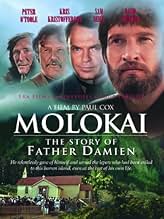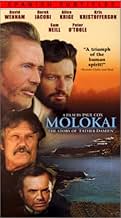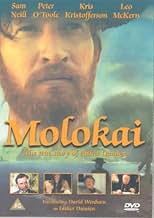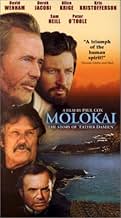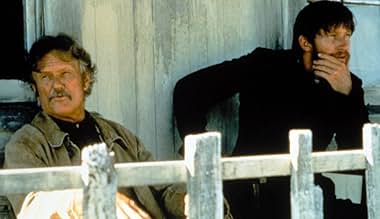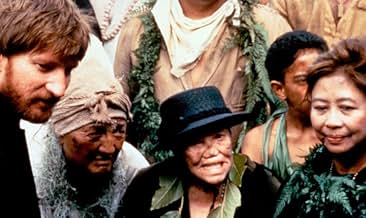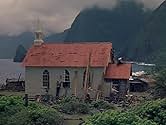IMDb-BEWERTUNG
6,9/10
1530
IHRE BEWERTUNG
Füge eine Handlung in deiner Sprache hinzuThe true story of the nineteenth century priest who volunteered to go to the island of Molokai, to console and care for the lepers.The true story of the nineteenth century priest who volunteered to go to the island of Molokai, to console and care for the lepers.The true story of the nineteenth century priest who volunteered to go to the island of Molokai, to console and care for the lepers.
- Auszeichnungen
- 1 Gewinn & 4 Nominierungen insgesamt
Empfohlene Bewertungen
We rented the movie this evening after spending today touring the tip of Molokai, Hawaii where this story took place. The movie is an excellent supplement for the tour. Richard Marks, our tour guide, did not tell us that he appears in many scenes throughout the movie. He is the tall man who has his feet wrapped in cloth in many scenes. He told us that the movie existed and some background stories about the movie.
Anyone wishing to tour this beautiful site should make sure, in advance, that Richard will be their guide. He is an excellent guide and also one of the people who has Hansen's Disease. He is 72 years old (2002) and a dynamic person.
Anyone wishing to tour this beautiful site should make sure, in advance, that Richard will be their guide. He is an excellent guide and also one of the people who has Hansen's Disease. He is 72 years old (2002) and a dynamic person.
The fact that this movie was primarily filmed in Kalaupapa on the north shore of our island, does not unduly influence my judgment that this is a very interesting movie. The acting of the "international" cast is quite fine. But so is that of my childhood friend, Keanu Kapuni-Szasz, as a young girl who contracts leprosy and later presents a slight temptation to Father Damien. Many, many "topside" Molokai residents joined with the few remaining Kalaupapa residents (who have Hansen's Disease) in this production. Viewers will be inspired by their beauty and spirit. Aloha.
I hate to be negative about a film that was obviously made with such good intentions, and I certainly don't want to offend anyone who sees Father Damien - the self-sacrificing Belgian priest - as a saint, but there isn't much that's positive to say about this inferior biopic. It isn't bad enough to be unwatchable, or good enough to deserve a second viewing. It's just very, very dull. I rented it on DVD and came to it open-minded but after half an hour I was struggling to stay awake. The opening twenty minutes are probably the best part of the movie, where the background is laid down and we see young, keen, fresh, athletic Father Damien striding off to fulfill his destiny.
I can't quite put my finger on what went wrong, although I have read of "dissension" between the director and producers. The cast, crew and financiers appear to be drawn from just about every nation on the face of the planet, and maybe that's one of the problems because the film has no distinctive "feel" to it; it's not a British movie or an Australian movie, or a Belgian movie, although all of those countries are well represented amongst the players and producers. What it so obviously lacked, was anyone strong enough on the production side to stamp some kind of distinctive character and style on it. It feels like a movie made by committee rather than created by artists. A committee may succeed in writing a technical manual, but it's not the way to create a passionate piece of cinema. And that's what it lacks. Passion.
Here we have a film set against stunning natural beauty; an ensemble cast list that reads like a Who's Who? of highly competent English speaking actors, (including Derek Jacobi, Leo McKern, Peter O'Toole, Sam Neill and David Wenham in the lead, with a mop top haircut that Ringo Starr would have envied in 1964); a moving, true story of a man who was obviously a remarkable human being; and more than enough controversy in his dealings with authority to create some real tension in the story. It's an appalling tale of the isolation and virtual abandonment of thousands of sick people from babies to grandparents, who had the misfortune to contract Leprosy at a time when it was still regarded as a biblical plague, and who were left to die alone in misery. That should be more than enough material for a really good movie, yet it's inexcusably dull, dull, dull, and really quite badly filmed. The photography looks "muddy" in shot after shot and some of the dialogue is hard to discern against what appears to be a permanent Force 8 gale.
It might work as an educational tract, (in fact it reminded me of some of the worthy but dire stuff I sat through 30 years ago in my last high school, a convent, when the teachers decided to go all "trendy" and treat us to an educational film) but it doesn't work as a cinematic piece. It would have been dull, even as a TV movie. Australian David Wenham gives an honest, engaging, workmanlike performance as the priest who arrives on Molokai expecting to take confessions and officiate at Mass, but finds himself instead making coffins for children, and trying to scrounge money for beds and medicines from uncaring superiors. Try as he might, he can't lift this one. (Anyone who has also seen Better than Sex will appreciate that he has range, and this movie is now 7 years old in fairness.) The film moves from scene to scene showing him treating the sick, comforting the dying, dragging people out of the surf, building houses etc etc. in an utterly formulaic way which never generates any real passion. He writes letters to HQ, and complains politely, but there is a remarkable lack of tension and drama in his dealings with his superiors. The sick shuffle around Molokai wrapped in rags, and we feel suitably uncomfortable, but it is all so dull. I wanted to be moved and I wasn't. Eventually Father Damien succumbs to Hansen's Disease (Leprosy) himself, literally giving his life for these forgotten people. It's a strong story that should have had audiences weeping in the aisles, but personally I was just glad when it finished. I can't really fault any of the individual performances, (in fact Aden Young was excellent as the young doctor and Sam Neill is always good value), it's just the overall effect that's so second rate.
Given the subject matter, it's really quite sad that such a good tale got such an inferior treatment. I know nothing about Father Damien but I'm sure he deserved better.
I can't quite put my finger on what went wrong, although I have read of "dissension" between the director and producers. The cast, crew and financiers appear to be drawn from just about every nation on the face of the planet, and maybe that's one of the problems because the film has no distinctive "feel" to it; it's not a British movie or an Australian movie, or a Belgian movie, although all of those countries are well represented amongst the players and producers. What it so obviously lacked, was anyone strong enough on the production side to stamp some kind of distinctive character and style on it. It feels like a movie made by committee rather than created by artists. A committee may succeed in writing a technical manual, but it's not the way to create a passionate piece of cinema. And that's what it lacks. Passion.
Here we have a film set against stunning natural beauty; an ensemble cast list that reads like a Who's Who? of highly competent English speaking actors, (including Derek Jacobi, Leo McKern, Peter O'Toole, Sam Neill and David Wenham in the lead, with a mop top haircut that Ringo Starr would have envied in 1964); a moving, true story of a man who was obviously a remarkable human being; and more than enough controversy in his dealings with authority to create some real tension in the story. It's an appalling tale of the isolation and virtual abandonment of thousands of sick people from babies to grandparents, who had the misfortune to contract Leprosy at a time when it was still regarded as a biblical plague, and who were left to die alone in misery. That should be more than enough material for a really good movie, yet it's inexcusably dull, dull, dull, and really quite badly filmed. The photography looks "muddy" in shot after shot and some of the dialogue is hard to discern against what appears to be a permanent Force 8 gale.
It might work as an educational tract, (in fact it reminded me of some of the worthy but dire stuff I sat through 30 years ago in my last high school, a convent, when the teachers decided to go all "trendy" and treat us to an educational film) but it doesn't work as a cinematic piece. It would have been dull, even as a TV movie. Australian David Wenham gives an honest, engaging, workmanlike performance as the priest who arrives on Molokai expecting to take confessions and officiate at Mass, but finds himself instead making coffins for children, and trying to scrounge money for beds and medicines from uncaring superiors. Try as he might, he can't lift this one. (Anyone who has also seen Better than Sex will appreciate that he has range, and this movie is now 7 years old in fairness.) The film moves from scene to scene showing him treating the sick, comforting the dying, dragging people out of the surf, building houses etc etc. in an utterly formulaic way which never generates any real passion. He writes letters to HQ, and complains politely, but there is a remarkable lack of tension and drama in his dealings with his superiors. The sick shuffle around Molokai wrapped in rags, and we feel suitably uncomfortable, but it is all so dull. I wanted to be moved and I wasn't. Eventually Father Damien succumbs to Hansen's Disease (Leprosy) himself, literally giving his life for these forgotten people. It's a strong story that should have had audiences weeping in the aisles, but personally I was just glad when it finished. I can't really fault any of the individual performances, (in fact Aden Young was excellent as the young doctor and Sam Neill is always good value), it's just the overall effect that's so second rate.
Given the subject matter, it's really quite sad that such a good tale got such an inferior treatment. I know nothing about Father Damien but I'm sure he deserved better.
This was a magnificent film. I had heard that there were some creative differences between director Paul Cox and other people involved in the film.
But this does not seem to affect the film in total. I found it a very moving uplifting film that presents the best the human species can aspire to. Like Mother Teresa and Gandhi Father Damian was probably a pain in the rear to the authorities civil and religious.
But that is the way of people who are so sure of their beliefs.
David Wenham, who is well known to Australian audiences, showed yet again what a talented actor he is.
The international actors who provided cameo roles were all excellent, particularly Peter O'Toole.
I've enjoyed Paul Cox's films many times over the years. They often win awards but are rarely major box office winners, But he has the ability to present the best of the human experience. He portrays real emotions and real people.
But this does not seem to affect the film in total. I found it a very moving uplifting film that presents the best the human species can aspire to. Like Mother Teresa and Gandhi Father Damian was probably a pain in the rear to the authorities civil and religious.
But that is the way of people who are so sure of their beliefs.
David Wenham, who is well known to Australian audiences, showed yet again what a talented actor he is.
The international actors who provided cameo roles were all excellent, particularly Peter O'Toole.
I've enjoyed Paul Cox's films many times over the years. They often win awards but are rarely major box office winners, But he has the ability to present the best of the human experience. He portrays real emotions and real people.
This story is quite faithful to the facts of the life of this remarkable Belgian priest who chose to live in a leper colony while still a man in his early 30's even though he knew it to be a permanent assignment and a death sentence.
The horrors of the leper colony were conveyed realistically while still giving a focus that would allow all but very young audiences to view it. The bureaucrats, both civil and religious, are well portrayed. -- (Derek Jacobi gives his usual fine performance in one of these roles.)
This is a "must see" for anyone who has never heard the story of Father Damien or knows little about the leper colony on Molokai.
The horrors of the leper colony were conveyed realistically while still giving a focus that would allow all but very young audiences to view it. The bureaucrats, both civil and religious, are well portrayed. -- (Derek Jacobi gives his usual fine performance in one of these roles.)
This is a "must see" for anyone who has never heard the story of Father Damien or knows little about the leper colony on Molokai.
Wusstest du schon
- WissenswertesLeo McKern's final credited movie role. He makes an uncredited appearance in Der Herr der Ringe: Die Gefährten (2001).
- PatzerFather Damien is shown performing a marriage between a man and a woman who was previously married but has not had an annulment granted by the Catholic Church. This is absolutely forbidden in the Church and would make the new marriage immediately invalid and cause the priest who willingly performed the marriage and the couple to be considered in a state of mortal sin. Father Damien never did any such thing and would not have.
- Zitate
Rudolph Meyer: From now on, only God can help you.
Father Damien: Yes, I often count on him.
- Crazy CreditsThe opening credits play over a scene of men on horseback with dogs searching a native village for lepers who have been hidden away by their families.
- VerbindungenFeatured in On Borrowed Time (2011)
Top-Auswahl
Melde dich zum Bewerten an und greife auf die Watchlist für personalisierte Empfehlungen zu.
- How long is Molokai?Powered by Alexa
Details
- Erscheinungsdatum
- Herkunftsländer
- Offizieller Standort
- Sprachen
- Auch bekannt als
- Molokai
- Drehorte
- Produktionsfirmen
- Weitere beteiligte Unternehmen bei IMDbPro anzeigen
Box Office
- Budget
- 7.436.800 € (geschätzt)
- Weltweiter Bruttoertrag
- 182.695 $
- Laufzeit
- 1 Std. 49 Min.(109 min)
- Farbe
- Sound-Mix
- Seitenverhältnis
- 2.35 : 1
Zu dieser Seite beitragen
Bearbeitung vorschlagen oder fehlenden Inhalt hinzufügen


